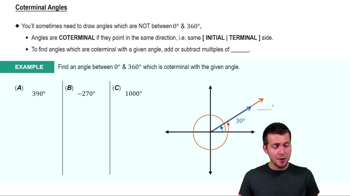Table of contents
- 0. Review of College Algebra4h 43m
- 1. Measuring Angles39m
- 2. Trigonometric Functions on Right Triangles2h 5m
- 3. Unit Circle1h 19m
- 4. Graphing Trigonometric Functions1h 19m
- 5. Inverse Trigonometric Functions and Basic Trigonometric Equations1h 41m
- 6. Trigonometric Identities and More Equations2h 34m
- 7. Non-Right Triangles1h 38m
- 8. Vectors2h 25m
- 9. Polar Equations2h 5m
- 10. Parametric Equations1h 6m
- 11. Graphing Complex Numbers1h 7m
1. Measuring Angles
Complementary and Supplementary Angles
Problem 3.63
Textbook Question
Convert each radian measure to degrees. Write answers to the nearest minute. See Example 2(c).
-5.01095
 Verified step by step guidance
Verified step by step guidance1
Recall the conversion factor between radians and degrees: $1 ext{ radian} = \frac{180}{\pi} ext{ degrees}$.
Multiply the given radian measure by the conversion factor: $-5.01095 \times \frac{180}{\pi}$.
Calculate the product to convert the radian measure to degrees.
Separate the decimal part from the whole number part of the degree measure.
Convert the decimal part of the degree measure to minutes by multiplying by 60, and round to the nearest minute.
Recommended similar problem, with video answer:
 Verified Solution
Verified SolutionThis video solution was recommended by our tutors as helpful for the problem above
Video duration:
0m:0sPlay a video:
Was this helpful?
Key Concepts
Here are the essential concepts you must grasp in order to answer the question correctly.
Radian to Degree Conversion
To convert radians to degrees, use the formula: degrees = radians × (180/π). This relationship stems from the definition of a radian, which is the angle subtended at the center of a circle by an arc equal in length to the radius. Understanding this conversion is essential for accurately translating angular measurements.
Recommended video:

Converting between Degrees & Radians
Understanding Minutes in Angles
In angular measurement, a degree can be subdivided into minutes, where 1 degree equals 60 minutes. This subdivision allows for more precise measurements of angles. When converting radians to degrees, it is important to express the final answer in degrees and minutes, especially when instructed to round to the nearest minute.
Recommended video:

Coterminal Angles
Negative Angles
Negative angles indicate a rotation in the clockwise direction, as opposed to the counterclockwise direction of positive angles. When converting a negative radian measure to degrees, the same conversion process applies, but the resulting degree measure will also be negative. This concept is crucial for understanding the orientation of angles in trigonometric contexts.
Recommended video:

Coterminal Angles

 3:35m
3:35mWatch next
Master Intro to Complementary & Supplementary Angles with a bite sized video explanation from Patrick Ford
Start learningRelated Videos
Related Practice








